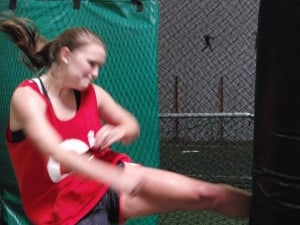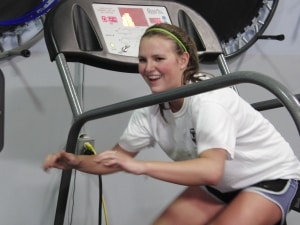Numerous studies that have been conducted over the past ten years indicate that females are indeed more susceptible to ACL injuries; most report that females are 4 to 8 times more likely to tear this ligament.
Proper technique training to include running, jumping, landing and footwork can reduce the likely hood of this injury. Movement skill is what prevents this injury and it is a year round process. Don’t fall into the trap of doing it as preseason work only. A simple schedule of twice a week or a moderate number of reps during your daily warm-up routine can be a great defense. Done properly these are great exercises:
Single leg balance squats
Step Ups
Depth Jumps
Speed Skaters
At Gamespeed we get our share of athletes coming off ACL rehab looking to get back in the game. Here’s the story of an athlete who was determined to get back on the field.
Val Margerum is starting her second year of soccer at Oregon State. She came to us last year to get back up to speed and just completed another summer training program with us this past July. She’s tough talented and a complete pleasure to work with. Her story can provide inspiration to the many athletes who have suffered the same injury and be a cautionary tale to prompt athletes to begin to be proactive in handling their bodies.
She wrote:
“Receiving the news that I had torn my ACL was probably the most gut-wrenching and surreal feeling I have ever experienced. It meant not only would I be missing my senior season of Campolindo High School soccer, it meant I would be going into preseason at Oregon State University the following summer at less than one hundred percent — a terrifying thought accompanied by a feeling of defeat and helplessness.
But my dad gave me some really great advice the day I received the news. He said: “Today, you can cry as much as you want. But tomorrow and everyday after that, you can’t feel sorry for yourself anymore — you can only work and make yourself better.” And although I cried a couple more times throughout that 9-month battle to recovery, that’s exactly what I did.
I had physical therapy multiple times a week both before and after surgery (in which a section of my hamstring tendon replaced my old ACL). Two months post-surgery, I had regained full range of motion; 4 months allowed me to start biking; 6 months – jogging.
So in May 2012, I started strengthening & conditioning at Gamespeed. Everything felt very awkward at first — I literally had to re-teach my body how to move.(I put her on a “movement education program” aimed at proper foot placement, knee tracking and hip mobility). 
In late June, I began cutting, lateral movement, & acceleration/deceleration: zig-zagging through cones, side-stepping onto boxes, shuffling, backpedaling, and even juggling the soccer ball with ankle weights on! My movements were finally feeling more natural again when I left for OSU in early July.
From there, I worked with our athletic trainer to get my sprint-endurance up & started practicing (contact!) with the team in August. By the time of our second non-conference game, I was 100% cleared. A week later, in my first collegiate start against UC Santa Barbara, my first touch on the ball was a shot (just wide), and about a minute later I went into a slide-tackle. Fearless as I was, my mom watching from the stands nearly had a heart attack anytime some one touched me.
By the end of fall season, I had gotten playing time in 13 matches; in winter, I continued to get stronger; in spring, I played 90 minutes in all 5 matches and scored my first collegiate goal.
As I’m now preparing for the upcoming season by playing in a summer league and working out at Gamespeed twice a week, it’s baffling that only a year ago I could barely sprint at all. It was a long, turbulant road to recovery, and it demands an incredible amount of work and determination, but with the support and encouragement of many people, I made it.”

